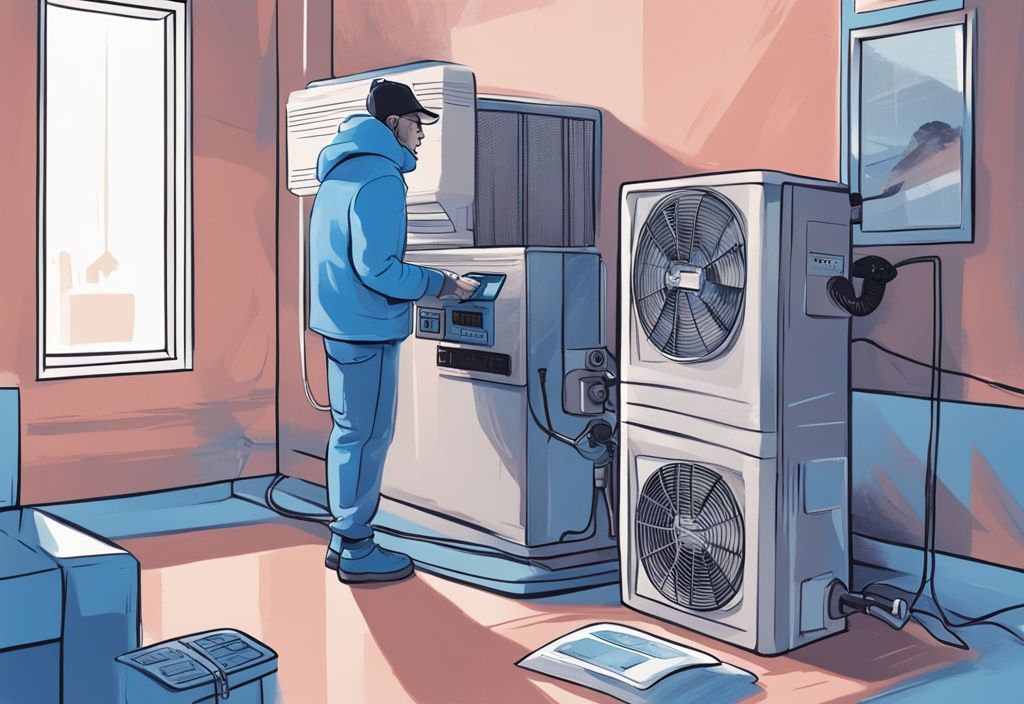Why Your Car AC Stops Blowing Cold Air: Expert Insights and Easy Fixes
Few things are as frustrating as stepping into your car on a sweltering day, only to find that your air conditioning isn’t blowing cold air. It’s a common issue that can turn any drive into an uncomfortable ordeal. I remember one summer afternoon when my own car’s AC decided to take a vacation—talk about bad timing! Whether you’re commuting to work or heading out on a road trip, a malfunctioning car AC can quickly become a major inconvenience.
There are several reasons why your car’s AC might stop cooling effectively. From low refrigerant levels to a faulty compressor, the causes can vary widely. But don’t worry—this guide is here to help you navigate through the potential problems and solutions. We’ll walk you through identifying the issue, recognizing warning signs, and even tackling some DIY fixes.
Understanding why your car AC isn’t performing as it should is the first step towards restoring your comfort. With expert insights and practical advice, this comprehensive guide aims to equip you with the knowledge needed to address the problem, whether you decide to fix it yourself or seek professional help. Let’s dive in and get your car’s AC back to blowing cold air.
Identifying the Issue: Why Your Car AC Isn’t Cooling
When your car’s AC isn’t blowing cold air, it can be a real head-scratcher. Let’s break down some of the common culprits behind this issue, so you can get back to enjoying a cool ride.
1. Low Refrigerant Levels
One of the top reasons your car AC might not be blowing cold air is low refrigerant levels. Think of refrigerant as the lifeblood of your AC system. It absorbs heat and cools the air, so without enough of it, your AC can’t do its job. Regular checks and recharges are key to keeping things running smoothly.
2. Refrigerant Leaks
Refrigerant leaks can be sneaky. Since the refrigerant evaporates when it hits the air, you might not notice it right away. Listen for clicks when the AC starts or hissing sounds when the engine is off. Look for oil residue around AC fittings and hoses. Fixing leaks usually means repairing or replacing parts and topping off the refrigerant.
3. Faulty Compressor
The compressor is like the heart of your AC system. If it goes out, so does your cool air. You might hear odd noises when the AC is on or notice the air isn’t cold even when the car is running. Diagnosing compressor issues often needs a pro to pinpoint the problem and find the right fix.
4. Clogged Condenser
The condenser cools the refrigerant after it’s compressed. If dirt or debris clogs it up, it can’t do its job. To ensure your air conditioning system runs efficiently, learn how to clean a window AC unit effectively. Regular cleaning helps prevent blockages and keeps your AC working at its best, so you stay cool on the road.
5. Broken Cooling Fans
Cooling fans help the condenser cool the refrigerant. If they’re not working, your AC will have a hard time blowing cold air. Check the fans for damage or failure. Replacing them when needed is crucial for effective cooling.
6. Faulty Thermostat
A bad thermostat can throw off the refrigerant’s temperature regulation, leading to poor cooling. Fixing thermostat issues often requires professional repair or replacement to get your AC back to blowing cold air.
7. Blocked or Leaking AC Lines
Blockages or leaks in the AC lines can seriously mess with your system’s cooling power. Inspect the lines for visible damage or leaks, and address any issues quickly to keep your AC in top shape.

8. Damaged Evaporator
The evaporator absorbs heat from your car’s interior. If it’s damaged, it can’t do its job well, and your cooling efficiency drops. Look for signs of leaks or damage, and consider getting professional repairs to restore your AC’s performance.
Warning Signs: Recognizing Car AC Problems
Ever wondered why your car AC isn’t blowing cold air? Let’s dive into some common warning signs that might help you figure out what’s going on.
1. Audible Clicks or Hissing Sounds
Hear that hissing or clicking? It might not just be the sound of summer bugs hitting your windshield. These noises often mean there’s a refrigerant leak, which is like your AC’s lifeblood escaping through cracks or loose connections. Without enough refrigerant, your AC can’t cool properly. Sometimes, these sounds also hint at trouble with the compressor, which is the heart of your AC system. Catching these noises early can save you from a world of hurt—and a sweaty drive.
2. Frequent Cycling of the AC
Does your AC have a mind of its own, turning on and off like it’s playing a game? This frequent cycling could be a sign of low refrigerant levels. Without enough refrigerant, the system struggles to maintain a steady cooling cycle. Another sneaky culprit could be a faulty thermostat, misreading the cabin temperature and causing unnecessary cycling. This not only messes with your comfort but can also wear out your AC parts faster than you’d like.
3. Oil Residue Around AC Fittings and Hoses
Spotted some oil around your AC fittings and hoses? That’s a telltale sign of a refrigerant leak. As the refrigerant escapes, it often drags some oil along for the ride, leaving behind a greasy residue. This residue is like a neon sign flashing “leak here!” Catching these leaks early can keep your AC running smoothly and your car cool.
4. Strange Noises from the Compressor
Is your compressor making noises that sound like it’s auditioning for a horror movie? Grinding or rattling sounds from the compressor are serious red flags. The compressor is crucial for compressing and circulating the refrigerant. If it’s making strange noises, it might be struggling due to internal damage or wear. Addressing these sounds quickly can prevent a complete compressor meltdown, saving you from more expensive repairs.
DIY Solutions: How to Fix Car AC Issues at Home
When your car AC isn’t blowing cold air, it can be frustrating, especially on a hot day. Fortunately, there are a few DIY solutions you can try to get that cool breeze back. Let’s dive into some practical steps you can take to troubleshoot and potentially fix the issue.
1. Checking Refrigerant Levels
One common culprit behind a car AC not blowing cold air is low refrigerant levels. Think of refrigerant as the lifeblood of your AC system. Grab a refrigerant gauge to check the current levels. If they’re running low, you might need to recharge the system. Just like topping off your car’s oil, it’s important to follow the manufacturer’s instructions here. Overfilling can cause more headaches than it solves. Keeping an eye on these levels can save you from future cooling hiccups.
2. Cleaning the Condenser
The condenser is like your AC’s front-line worker, cooling the refrigerant after it’s been compressed. Over time, it can get bogged down with dirt and debris. To give it a good clean, locate it at the front of your vehicle. Use a gentle stream of water to wash away the grime. Be gentle, though—those fins are delicate! A clean condenser means better airflow and cooling efficiency, which is crucial for your AC’s performance.

3. Inspecting Cooling Fans
Cooling fans are the unsung heroes of your AC system, helping to dissipate heat from the condenser. If they’re damaged or blocked, your AC might not blow cold air. Take a look at the fans for any visible damage or debris. Make sure they spin freely and aren’t making any strange noises. If something seems off, it might be time for a replacement to get that cool air flowing again.
4. Ensuring Cabin Air Filter Is Not Clogged
A clogged cabin air filter can choke off airflow, leaving you with a less-than-cool ride. Depending on your car model, you’ll find the filter behind the glove compartment or under the dashboard. Pull it out and check for dirt and debris. If it looks like it’s seen better days, swap it out for a new one. Regularly replacing the cabin air filter keeps the air fresh and the cooling at its best.
5. Using a Voltmeter to Check Compressor Voltage
The compressor is the powerhouse of your AC system, and it needs the right voltage to do its job. A voltmeter can help you check if it’s getting what it needs. If the voltage is low, there might be an electrical issue to tackle. Inspect the wiring and connections for any damage or corrosion. Ensuring the compressor has the right voltage is key to keeping that cold air coming from your car’s AC.
When to Call the Pros: Seeking Professional Help for Car AC Issues
Sometimes, car AC problems can be tricky and need a professional touch. Whether it’s handling refrigerant, diagnosing complex issues, or dealing with persistent problems, knowing when to call in the experts can save you time and hassle.
1. Handling Refrigerant Safely
Refrigerant is the lifeblood of your car’s AC system, but it’s also a bit of a troublemaker if not handled right. If you’re scratching your head wondering why is my car AC not blowing cold air, low refrigerant might be the culprit. But here’s the thing—recharging or messing with refrigerant isn’t a weekend DIY project. Professionals have the right gear and know-how to handle it safely, making sure your system is topped up without any toxic mishaps. This keeps you safe and your AC running smoothly.
2. Complex Repairs and Diagnoses
Car AC systems can be as complicated as a jigsaw puzzle. A faulty compressor or thermostat might be why your car AC isn’t blowing cold air, but pinpointing the issue requires more than a guess. Pros come armed with advanced diagnostic tools and the expertise to tackle these tricky parts. Trying to fix it yourself without the right knowledge can turn a small problem into a big one. So, letting the experts handle it is often the best bet.
3. Persistent AC Issues Despite DIY Efforts
You’ve given it your best shot, but your car AC still isn’t blowing cold air. Sometimes, persistent issues hint at deeper problems that aren’t obvious at first glance. Professionals can dig deeper, providing a thorough inspection and a solid diagnosis. They’ll not only fix the current hiccup but also help ward off future breakdowns, ensuring your AC remains a trusty companion on the road.
FAQs: Your Questions About Car AC Problems Answered
Car AC problems can be a real headache, especially when you’re expecting a cool breeze and get nothing but warm air. Here, we’ll tackle some common questions to help you understand and solve these issues.

What should I do if my car AC is not blowing cold air?
- First things first, check those refrigerant levels. It’s like checking if your fridge is plugged in when it’s not cooling. If you spot any leaks or damage, that’s your cue to get those fixed. Often, addressing these straightforward issues can bring back the chill.
How often should I recharge my car’s AC refrigerant?
- Generally, a recharge every 1-2 years should do the trick. But hey, don’t just take my word for it—your car’s manual is your best buddy for specific advice tailored to your model.
Can I drive my car with a faulty AC compressor?
- Sure, you can drive it, but I’d advise against it. A dodgy compressor can mess up the whole AC system, leading to bigger repair bills down the road.
How can I detect a refrigerant leak in my car AC?
- A UV AC leak detection kit is your best friend here. It’s like having a flashlight in the dark. Alternatively, keep an eye out for oil residue around AC fittings and hoses—it’s a telltale sign of a leak.
What maintenance can prevent car AC issues?
- Regular maintenance is key. Check refrigerant levels, clean the condenser, and swap out those air filters. These simple steps can keep your car’s AC running smoothly and extend its life.
Conclusion
Keeping your car’s AC in top shape is crucial, especially when the summer sun turns your vehicle into a sauna. Regular maintenance and timely fixes are your best friends in making sure that your car’s air conditioning stays efficient. If you find your car AC not blowing cold air, it’s time to roll up your sleeves and get to the bottom of it. Ignoring the problem might just lead to bigger headaches and steeper repair bills down the road.
Think of routine checks as your AC’s wellness plan. Keep an eye on the refrigerant levels and make sure parts like the condenser and cooling fans are in tip-top condition. These simple steps can ward off many common AC troubles. Not only do they extend the life of your AC, but they also keep your car cool and comfy.
While some fixes are as easy as pie and can be done at home, sometimes you need to call in the cavalry. If you’re dealing with a dodgy compressor or a pesky refrigerant leak, it’s best to let a pro handle it. A seasoned technician will give your system a thorough once-over and ensure repairs are done safely. This way, you protect both your car and your peace of mind.
In the end, knowing why your car AC isn’t blowing cold air and taking the right steps can make all the difference. With regular upkeep and expert help when needed, you can enjoy a smooth and breezy ride, no matter how hot it gets outside.




Post Comment